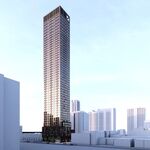GraphicMatt
Looking forward to a FRESH START for Toronto
It's still the most bone-headed idea you've ever heard? How much have you read about the mayor's plan to fund the subway through magical private sector money?
It's still the most bone-headed idea you've ever heard? How much have you read about the mayor's plan to fund the subway through magical private sector money?
I wouldn't say never. However a Sheppard West and Sheppard East LRT terminating at platform level would need to occur before it would happen. At that point, especially with an Eglinton LRT subway operation, people would wonder what the point of it all is and really question the numbers being thrown at them. The new downtown cars will run on the same gauge rail, be shorter than subways (the old cars were 3.62m, the new ones will be about 3.4m, the subways are 3.65m) so the basic equipment will exist, the modification being a reduction of the custom features used for the downtown cars, a coupler, and a secondary power collection mechanism that can be deployed while entering the tunnel. The tunnels already exist so the big expense is cutting into the platform to lower it.
I'm not sure it's the best idea ... but it's no where near as boneheaded as Ford's plan to cancel the Sheppard East LRT and replace it with nothing.And why it's the most bone-headed idea I've ever had the mispleasure of hearing?
I'm not sure it's the best idea ... but it's no where near as boneheaded as Ford's plan to cancel the Sheppard East LRT and replace it with nothing.
I'm not sure it's the best idea ... but it's no where near as boneheaded as Ford's plan to cancel the Sheppard East LRT and replace it with nothing.
Residents along Sheppard Avenue who live near future subway stations had better get used to the idea of very tall buildings next door to them.
According to Dr. Gordon Chong, Toronto Transit Investment Ltd.'s CEO, buildings on the scale of the Minto highrise at Yonge and Eglinton - between 30 and 40 storeys tall - will be part of the cost of any kind of public private partnership that extends the Sheppard subway deep into Scarborough.
And he warned that city councillors supporting such a plan had better get behind the idea of up-zoning Sheppard, even against the wishes of their own constituents.
"People don't want it, but at some point you have to make a decision," said Chong in an interview with Toronto Community News. "This year is the five-year review of Toronto's Official Plan. So it's going to be incumbent on people who claim to be city builders - they may have to screw up their courage and say, 'we have to upzone.'"
Chong made the comments the day after a raucus meeting at Toronto's planning and transportation committee, where councillors skeptical about Mayor Rob Ford's $4.2-billion plan to build a subway along Sheppard squared off against supporters of the mayor's public-private sector plan.
At the meeting, councillors and members of the public suggested that the financing for the plan was ill thought-out, and would require serious compromises on the urban form in Scarborough.
A rendering obtained by Toronto Community News, and supplied by the Tridel development group to city planners, showed what the intersection of Victoria Park Avenue and Sheppard Avenue East might look like after it were redeveloped using density rights allocated from the subway station.
The plan would fill each corner of the intersection with a massing of seven towers and numerous smaller buildings there. The towers would range between 20 and 40 storeys in height.
Chong said that those sorts of densities are part of what will be required to build subways rather than the less costly light rail plan that the Ford administration cancelled earlier this year.
He said that Ford's plan to have the private sector pick up the tab will require a massive public sector investment. He said that at most, the city can expect 40 per cent of the cost of the project to be borne by private sector investment.
"In Spain there have been infrastructure projects where the private sector covers 50 per cent of things – but realistically, 10-40 per cent is the maximum," he said.
"It shouldn't come as any surprise that senior levels of government have to get back in. The federal government is on board, already agreed to have $330 million being reallocated to Sheppard. And we're applying for more P3 funding as well."
But there will have to be more investment than that. Because the Ford administration has already rejected the idea of using road tolls as a way to finance the subway, federal money and provincial money will have to flow relatively freely in order for the subway to be built.
"The federal government will have to be reminded that it's not 1867 - it's 2011," he said. "Eighty per cent of the country's population is concentrated in urban areas. What they need to do is push the envelope of constitutional arrangements without tearing the envelope."
And as for road tolls? In an interview on the weekend, Chong was quoted as saying that road tolls were a tool that would likely have to be considered to come up with the cost of the subway.
"Road tolls are a tool in the toolbox," he said.
"I was hired to put all the options on the table and that's what I'm doing. Road tolls are off the table for the Ford administration. But they're still part of the toolbox. If you choose not to use that tool, that's your choice."
$175? St. Clair was $105 million ... and $30 million of that was the Toronto Hydro project. So $75 million - or about $11 million per kilometre.to be honest $300 million/km isn't high, I'd actually be ecstatic if it stayed at that figure. It does really make you think, though, that the entire st. clair ROW wiht delays and court fights, cost a mere $175....
$175? St. Clair was $105 million ... and $30 million of that was the Toronto Hydro project. So $75 million - or about $11 million per kilometre.
Though the $300 million is all in (design, land, vehicles, yards, etc., etc., etc.) and the $11 million is mostly just construction - not even sure if it includes design. Construction of the subway tunnel itself for Spadina is only a fraction of the $300 million cost.




